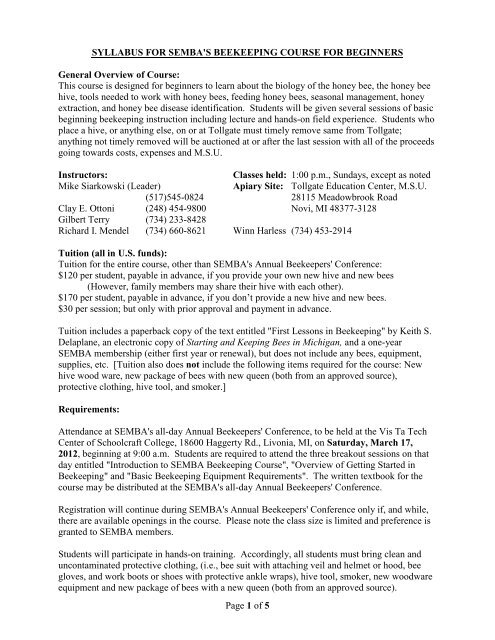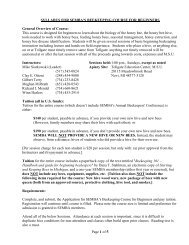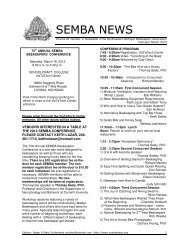syllabus for semba's beekeeping course for beginners
syllabus for semba's beekeeping course for beginners
syllabus for semba's beekeeping course for beginners
Create successful ePaper yourself
Turn your PDF publications into a flip-book with our unique Google optimized e-Paper software.
SYLLABUS FOR SEMBA'S BEEKEEPING COURSE FOR BEGINNERS<br />
General Overview of Course:<br />
This <strong>course</strong> is designed <strong>for</strong> <strong>beginners</strong> to learn about the biology of the honey bee, the honey bee<br />
hive, tools needed to work with honey bees, feeding honey bees, seasonal management, honey<br />
extraction, and honey bee disease identification. Students will be given several sessions of basic<br />
beginning <strong>beekeeping</strong> instruction including lecture and hands-on field experience. Students who<br />
place a hive, or anything else, on or at Tollgate must timely remove same from Tollgate;<br />
anything not timely removed will be auctioned at or after the last session with all of the proceeds<br />
going towards costs, expenses and M.S.U.<br />
Instructors:<br />
Classes held: 1:00 p.m., Sundays, except as noted<br />
Mike Siarkowski (Leader)<br />
Apiary Site: Tollgate Education Center, M.S.U.<br />
(517)545-0824 28115 Meadowbrook Road<br />
Clay E. Ottoni (248) 454-9800 Novi, MI 48377-3128<br />
Gilbert Terry (734) 233-8428<br />
Richard I. Mendel (734) 660-8621 Winn Harless (734) 453-2914<br />
Tuition (all in U.S. funds):<br />
Tuition <strong>for</strong> the entire <strong>course</strong>, other than SEMBA's Annual Beekeepers' Conference:<br />
$120 per student, payable in advance, if you provide your own new hive and new bees<br />
(However, family members may share their hive with each other).<br />
$170 per student, payable in advance, if you don’t provide a new hive and new bees.<br />
$30 per session; but only with prior approval and payment in advance.<br />
Tuition includes a paperback copy of the text entitled "First Lessons in Beekeeping" by Keith S.<br />
Delaplane, an electronic copy of Starting and Keeping Bees in Michigan, and a one-year<br />
SEMBA membership (either first year or renewal), but does not include any bees, equipment,<br />
supplies, etc. [Tuition also does not include the following items required <strong>for</strong> the <strong>course</strong>: New<br />
hive wood ware, new package of bees with new queen (both from an approved source),<br />
protective clothing, hive tool, and smoker.]<br />
Requirements:<br />
Attendance at SEMBA's all-day Annual Beekeepers' Conference, to be held at the Vis Ta Tech<br />
Center of Schoolcraft College, 18600 Haggerty Rd., Livonia, MI, on Saturday, March 17,<br />
2012, beginning at 9:00 a.m. Students are required to attend the three breakout sessions on that<br />
day entitled "Introduction to SEMBA Beekeeping Course", "Overview of Getting Started in<br />
Beekeeping" and "Basic Beekeeping Equipment Requirements". The written textbook <strong>for</strong> the<br />
<strong>course</strong> may be distributed at the SEMBA's all-day Annual Beekeepers' Conference.<br />
Registration will continue during SEMBA's Annual Beekeepers' Conference only if, and while,<br />
there are available openings in the <strong>course</strong>. Please note the class size is limited and preference is<br />
granted to SEMBA members.<br />
Students will participate in hands-on training. Accordingly, all students must bring clean and<br />
uncontaminated protective clothing, (i.e., bee suit with attaching veil and helmet or hood, bee<br />
gloves, and work boots or shoes with protective ankle wraps), hive tool, smoker, new woodware<br />
equipment and new package of bees with a new queen (both from an approved source).<br />
Page 1 of 5
To help reduce the risk of introducing pests, students electing to temporarily have a hive at<br />
Tollgate will need to provide all new hive equipment and a new package of bees with a new<br />
queen (both from an approved source). New hive equipment includes all new woodware that<br />
includes at least one new outer cover, one new inner cover, at least six (6) new hive bodies, at<br />
least sixty (60) new frames with new foundation (added just prior to use), one new bottom board,<br />
one new entrance reducer, and one new hive support.<br />
Anyone re-installing a queen and/or any other bee(s) must also acquire them from an approved<br />
source. One such source may include the Advance Beekeeping Course at Tollgate; if available, a<br />
queen within a cage (which cage is to be promptly returned) and a drawn out frame of brood may<br />
be purchased <strong>for</strong> $30 (plus one new, unused replacement frame and foundation). Please note that<br />
this alternative source not your only approved source and is only being offered as a possible<br />
convenience.<br />
Reading text is a must. Attendance at each session is important, since it is difficult to duplicate<br />
hive conditions <strong>for</strong> non-attendees and classes often build upon prior classes.<br />
All participants must properly maintain all items left at Tollgate and conduct themselves in a<br />
friendly and helpful manner, following all rules.<br />
INTRODUCTION TO BEEKEEPING SYLLABUS<br />
OVERVIEW<br />
SESSION 1, MARCH 17, at the Vis Ta Tech Center of Schoolcraft College, 18600 Haggerty<br />
Rd., Livonia, MI, beginning at 9:00 a.m.<br />
• Introduction to SEMBA Beekeeping Course.<br />
• Overview of Getting Started in Beekeeping.<br />
• Basic Beekeeping Equipment Requirements.<br />
"SPRING" MANAGEMENT<br />
SESSION 2, MARCH 18 (Be<strong>for</strong>e the class, read text pages: 29-40 and 44-48)<br />
• Introduction to Tollgate and discuss rules.<br />
• Discuss <strong>beekeeping</strong> and setting goals.<br />
• Synopsis of Langstroth alternatives such as top bar hives, Warre hives and skeps.<br />
• Discuss hive placement.<br />
• TO DO: Bring hive woodware [i.e., outer cover, inner cover, boxes, frames, foundation,<br />
screened bottom board, entrance reducer and feeder (wood hive stand, optional)]<br />
to be constructed.<br />
• TO DO: Bring hammer, waterproof exterior glue, correctly sized nails <strong>for</strong> frames and hive<br />
bodies, and staples (air compressor and air powered crown staple gun).<br />
(Optional: 1½” x ¼” crown staples and air powered crown staple gun or 2”, #6<br />
deck screws and power driver.)<br />
• TO DO: Identify future hive placement and hive owner by number, <strong>for</strong> reference purposes.<br />
• TO DO: Begin (or continue) to construct hive equipment.<br />
• TO DO: Optional, at your location, prime or stain exterior surfaces of hive.<br />
• TO DO: Optional, at your location, paint any primed exterior surfaces of hive.<br />
Page 2 of 5
SESSION 3, MARCH 25 (Be<strong>for</strong>e the class, read text pages: 1-21 and 49-56)<br />
• Identify five (5) key points from last Session.<br />
• Discuss foundation.<br />
• Discuss installation of bee packages.<br />
• Brief overview of bee pests and pathogens, as well as possible interventions.<br />
• Discuss possibly medicating packages.<br />
• Discuss feeding bees - why, what, when and how.<br />
• TO DO: Start to set up bee yard (bring carpet & hive support such as bricks, blocks & rocks).<br />
• TO DO: Continue to construct hive equipment, bring items and supplies.<br />
• TO DO: Inspect dead overwintered hive(s), if any.<br />
• TO DO: Optional, at your location, prime & paint, or stain, exterior surfaces of hive.<br />
SESSION 4, APRIL 15 (Be<strong>for</strong>e the class, read text pages: 22-28, 41-43 and 125-140)<br />
• Identify five (5) key points from last Session.<br />
• Answer questions regarding installation of packages.<br />
• Answer questions regarding feeding, and possibly medicating, packages.<br />
• Discuss inspecting overwintered hives.<br />
• Discuss feeding and medicating overwintered hives.<br />
• TO DO: "De-winterize" overwintered hive(s), bring camera.<br />
• TO DO: Look at overwintered hives.<br />
• TO DO: Complete construction of hive equipment, bring items and supplies.<br />
• TO DO: Complete bee yard (bring carpet & hive support such as bricks, blocks & rocks).<br />
• TO DO: Set up hive <strong>for</strong> bees (bring completed hive equipment including bricks or rocks).<br />
• TO DO: Finish construction of hive equipment, bring items and supplies.<br />
• TO DO: Finish, at your location, prime & paint, or stain, exterior surfaces of hive.<br />
SESSION 5, APRIL (Evening of a date to be determined based upon arrival of bee packages)<br />
• TO DO: Bring protective clothing, hive tool, and smoker.<br />
• TO DO: Bring, if not already at Tollgate, outer cover, inner cover, feeder, spacer, at least two<br />
(2) brood boxes, at least ten (10) frames with foundation, bottom board, entrance reducer,<br />
carpet & hive support such as bricks, blocks & rocks, as well as bricks or rock <strong>for</strong> top.<br />
• TO DO: Bring sugar syrup (and, optionally, medication).<br />
• TO DO: Optional, medicate packages.<br />
• TO DO: Install packages.<br />
• TO DO: Feeding bees in the hive (and continue to do so).<br />
SESSION 6, APRIL 29 (Be<strong>for</strong>e the class, read text pages: 57-58, 61-64, and 75-77)<br />
• Identify five (5) key points from last Session.<br />
• Discuss what to look <strong>for</strong> when inspecting a new hive.<br />
• Discuss feeding new and overwintered hives.<br />
• Discuss medicating new and overwintered hives organically and otherwise.<br />
• Discuss equalizing and splitting overwintered hives.<br />
• TO DO: Inspect overwintered hives, consider feeding and medication.<br />
• TO DO: Consider splitting overwintered hives.<br />
• TO DO: Inspect new hives.<br />
• TO DO: Feed new hives.<br />
Page 3 of 5
SESSION 7, MAY 20 (Be<strong>for</strong>e the class, read text pages: 59, 60, and 66-72)<br />
• Identify five (5) key points from last Session.<br />
• Discuss inspecting all hives <strong>for</strong> queens and brood.<br />
• Discuss swarming.<br />
• TO DO: Install drone comb in overwintered hives <strong>for</strong> Integrated Pest Management (IPM).<br />
• TO DO: Inspect all hives <strong>for</strong> queen and brood.<br />
• TO DO: Add second brood chamber to new hives.<br />
• TO DO: Feed if needed.<br />
"SUMMER" MANAGEMENT<br />
SESSION 8, JUNE 3 (Be<strong>for</strong>e the class, read text pages: 73-75 and 78-85)<br />
• Identify five (5) key points from last Session.<br />
• Discuss Michigan honey flows.<br />
• Discuss importance of nucs in the bee yard.<br />
• Discuss honey supering (why, when, and how).<br />
• Discuss drone comb and swarm cells.<br />
• TO DO: Inspect and feed new hives.<br />
• TO DO: Add second or third brood chamber to new hives.<br />
• TO DO: Add honey supers to overwintered hives.<br />
SESSION 9, JUNE 24 (Be<strong>for</strong>e the class, read text pages: 118-125 and 141-143)<br />
• Identify five (5) key points from last Session.<br />
• Discuss pests<br />
• Discuss and demo sugar roll.<br />
• Discuss IPM and types of treatments (e.g., broad interruption options).<br />
• Discuss queen replacement as well as swarm, supersedure and emergency cells.<br />
• Discuss summer increases (making nucs and addressing queens in nucs).<br />
• TO DO: Inspect hives and continue IPM.<br />
• TO DO: Super where needed.<br />
SESSION 10, JULY 15 (Be<strong>for</strong>e the class, read text pages: 105-117)<br />
• Identify five (5) key points from last Session.<br />
• Discuss pathogens and treatment<br />
• Discuss thinking ahead -- issues and opportunities.<br />
• Discuss extracting surplus honey, if any.<br />
• Answer questions regarding IPM check <strong>for</strong> pests (e.g., mites).<br />
• Questions and answers (If students don't ask, instructors will.)<br />
• TO DO: Check supers.<br />
• TO DO: IPM check <strong>for</strong> pests (e.g., mites), treat if necessary and honey will not be extracted.<br />
Page 4 of 5
SESSION 11, AUGUST 5 (Be<strong>for</strong>e the class, read text pages: 85-97)<br />
• Identify five (5) key points from last Session.<br />
• Discuss products from the hive.<br />
• Discuss how to move hives.<br />
• TO DO: Inspect nucs.<br />
• TO DO: IPM, monitor hives <strong>for</strong> pests such as varroa mites, treat if necessary.<br />
• TO DO: Consider feeding hives [e.g., nuc's, light hives & those with pulled honey super(s)].<br />
• TO DO: Pull honey, if any surplus.<br />
• TO DO: Select honey supers <strong>for</strong> extraction -- either by agreement or by pulling "numbers from<br />
a hat".<br />
• RETURN TO CLASS: <strong>for</strong> demonstration of extraction, as well as introduction to bottling,<br />
wax rendering and candle making.<br />
"FALL" MANAGEMENT<br />
SESSION 12, AUGUST 26 (Be<strong>for</strong>e the class, read text pages: 99-100)<br />
• Identify five (5) key points from last Session.<br />
• Discuss whether to feed or, in the alternative, to super <strong>for</strong> fall honey.<br />
• Discuss fall requeening (using nucs or not).<br />
• Discuss what to do with nucs.<br />
• Discuss how to move hives.<br />
• TO DO: Check nucs (feed).<br />
• TO DO: Inspect hive <strong>for</strong> mites, remove treatments.<br />
• TO DO: Feed hive.<br />
SESSION 13, SATURDAY, SEPTEMBER 8, at 9:00 a.m.<br />
• TO DO: Remove hives and all related items.<br />
(STUDENTS MUST REMOVE THEIR RESPECTIVE HIVE AND ALL RELATED<br />
ITEMS FROM TOLLGATE EDUCATION CENTER. ANYTHING NOT TIMELY<br />
REMOVED (i.e., ABANDONED ITEMS) WILL BE AUCTIONED AT OR AFTER THE<br />
LAST SESSION WITH ALL OF THE PROCEEDS GOING TOWARDS COSTS,<br />
EXPENSES AND M.S.U.)<br />
"WINTER" MANAGEMENT<br />
SESSION 14, SEPTEMBER 23 (Be<strong>for</strong>e the class, read text pages: 22 and 99-104)<br />
• Identify five (5) key points from last Session,<br />
• Discuss getting ready <strong>for</strong> winter.<br />
• Discuss overwintering hives.<br />
• Discuss getting ready <strong>for</strong> next year including reviewing "to-do's" such as attending seminars,<br />
reading <strong>beekeeping</strong> journals, ordering and constructing equipment, and early spring hive<br />
management.<br />
• General discussion.<br />
• AUCTION OF ABANDONED ITEMS.<br />
Page 5 of 5





